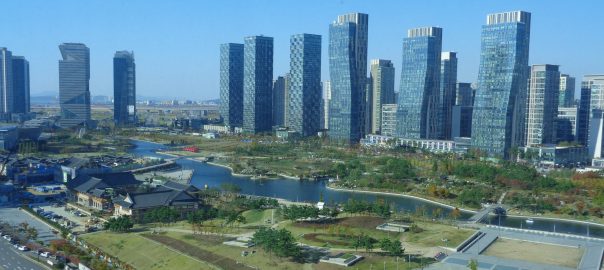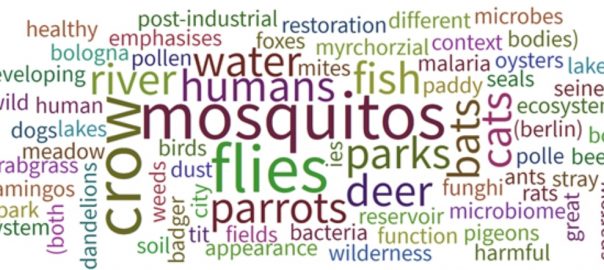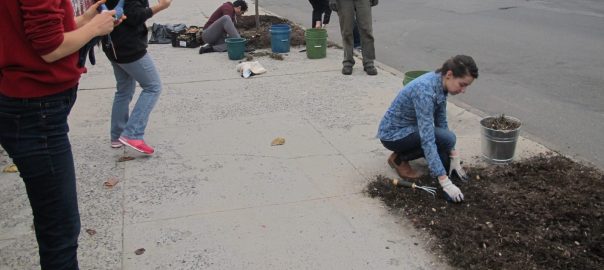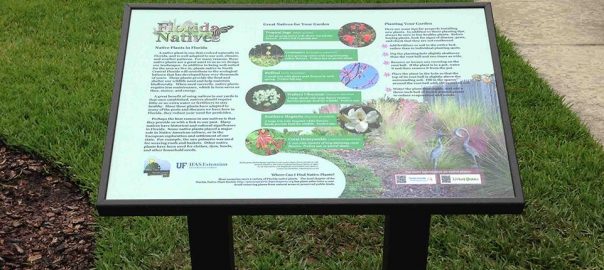 In 1993 or thereabouts I entered a contest for women to depict what they did on a particular day. That day, I went to meetings early in the morning at Harlem Hospital. I took photos of the abandoned buildings on West 136th, where I parked my car, and photos of a huge plastic bag in one of the stunted trees. Later, on my way back to my office on W. 166th Street, I stopped to take a photo of man who was selling nuts on the street in front of a burned-out building. He smiled with tremendous pride—when I took him a copy of the photo a few weeks later, he grinned and said he’d send it to his mother so she would know he was trying to make something of himself. There were photos of the Stuyvesant High School students that I was mentoring for the Westinghouse Science Competition, and photos at home in Hoboken with my daughter Molly and some chocolate chip cookies fresh out of the oven. We were reading Ian Frazier’s New Yorker article about plastic bags in trees. I didn’t win the contest, but the exercise etched what I saw in memory.
In 1993 or thereabouts I entered a contest for women to depict what they did on a particular day. That day, I went to meetings early in the morning at Harlem Hospital. I took photos of the abandoned buildings on West 136th, where I parked my car, and photos of a huge plastic bag in one of the stunted trees. Later, on my way back to my office on W. 166th Street, I stopped to take a photo of man who was selling nuts on the street in front of a burned-out building. He smiled with tremendous pride—when I took him a copy of the photo a few weeks later, he grinned and said he’d send it to his mother so she would know he was trying to make something of himself. There were photos of the Stuyvesant High School students that I was mentoring for the Westinghouse Science Competition, and photos at home in Hoboken with my daughter Molly and some chocolate chip cookies fresh out of the oven. We were reading Ian Frazier’s New Yorker article about plastic bags in trees. I didn’t win the contest, but the exercise etched what I saw in memory.
The extreme commodification of the land is leading to the destruction of human habitat. It is inimical to public health to sell off our neighborhoods and displace our communities.
The more I learned, the more I realized that urban policies were playing a critical role in the neighborhood’s collapse. From the stories people told us, I hypothesized that Harlem had collapsed from a series of blows, each one undermining and deforming the social structure, so that death and disorder replaced hope and social productivity. As my colleagues at the Cities Research Group and I deepened our explorations, we were able to name the terrible series of policies—urban renewal, deindustrialization, planned shrinkage, mass incarceration, HOPE VI, the foreclosure crisis and gentrification—that have and continue to undermine poor and minority communities.
We’ve grouped these policies together under the rubric “serial forced displacement.” Displacement traumatizes people and destroys wealth of all kinds. Repeated displacement takes even more of the wealth and integrity of the weakened population. As St. Matthew put it, “even what he has shall be taken away.” Through the lens of the agony of Harlem, I learned the somber fact that policies that destroy some communities and neighborhoods are catastrophic for the health of those in the direct path of the upheaval, but they also endanger the health of the whole of the US, and through us, the whole world.
Let us take one example, New York City’s implementation of the mid-1970s policy of “planned shrinkage.” This policy was designed to manage “shrinking population” in the city by “internal resettlement” of people from very poor neighborhoods and clearing the land for later use. Planned shrinkage was implemented by closing fire stations in those communities. This triggered a storm of fires: South Bronx neighborhoods lost as much as 80 percent of housing; Harlem lost 30 percent.
We can trace many lines of disruption that rippled out from these epicenters of destruction. The upheaval caused massive social disorder and a “synergism of plagues,” as Rodrick Wallace called it. What no one knew when the policy was implemented was that a new virus—which we now know as the Human Immunodeficiency Virus (HIV)—was present in the very poor neighborhoods. HIV began to spread in the South Bronx and other NYC communities. The crack epidemic took hold, accompanied by massive violence, family disruption, and further spread of HIV infection. Mass incarceration was the federal response to the drug epidemic, unleashing an era of imprisonment that had horrific consequences for families and neighborhoods. By 2015, The New York Times reported “1.5 million missing black men,” many in prison and others who had died prematurely. Population fell, families fell apart, unemployment grew, church attendance declined, and trauma became a nearly universal experience.
Having hypothesized the downward spiral of community collapse, my team and I realized we had to start searching for ways to rebuild. We worked first with families, then neighborhoods. But we learned that the fate of neighborhoods rested in the hands of cities. A great deal of our attention has been directed at learning what actions cities could take to counter serial forced displacement and to rebuild the much-needed social bonds.
In 2007, I went to my hometown of Orange, NJ, for a celebration of the 50th anniversary of the fight against school desegregation. My parents, Ernest and Margaret Thompson, had led that fight. My father went on to organize for the political representation long denied to the African-American population, then 20 percent of the city. In 1958, he and others in Citizens for Representative Government created the “New Day Platform,” which advocated for education, youth recreation, representative government and a more beautiful city hall, among other issues. Their work led to a more inclusive democracy and better schools for all children.
While planning for the celebration of Orange’s desegregation, I learned that a local community development corporation, HANDS, Inc. was continuing the work my father had pioneered. It was fighting to protect local housing infrastructure and to rebuild community in the face of serial forced displacement. I became so interested in the city of Orange that in 2008 I co-founded the free people’s University of Orange along with Patrick Morrissy, Molly Rose Kaufman, Karen Wells and others.
The University of Orange has participated actively in planning efforts in the city. The UofO lead the development of the Heart of Orange Plan, which became an official plan in 2010, endorsed by the state of New Jersey Department of Community Affairs, making the area eligible for tax credit monies. We have also invited architects and urbanists from Columbia University, Parsons The New School for Design, Montclair State University and Pratt Institute to work with us to understand the city. We have slowly developed a sense of the city’s potentials and its vulnerabilities.
Orange grew at the foot of the Watchung Mountains, a crossroads of east-west and north-south movement, in the heart of the Lenapehoking. Its excellent water and good transportation made it a natural site for industry. Hat making boomed after the Civil War, reaching a peak of 4.2 million hats a year in 1892. The new bourgeoisie equipped the city with a Stanford White library on a busy Main Street, a Frederick Law Olmsted Park and housing enclave, dozens of churches and synagogues, two settlement houses and a park-like cemetery. The African-Americans and Irish and Italian immigrants were tucked into ghettoes, their children sent to inferior public schools, while the well-to-do created superb schools and tracks for their own children to prosper. The city is so packed with the best and worst of American urban accoutrements that the University of Orange has developed a signature tour, called “Everything You Want to Know About the American City You Can Learn in Orange, NJ.” Orange has the advantage of being a small city, so visitors can see all of this in 2.2 square miles.
But Orange now, like many other postindustrial cities, is worn-out. Sixty-five percent of the largely black population of 30,000 is poor and working poor. Many residents have immigrated from other countries and they speak a wide array of languages. Orange is a city in search of a future. In New Jersey, such places are being converted by “transit-oriented development,” which means the unskilled workers are being replaced by those who commute to Newark—or more likely New York—to work in finance, insurance and real estate, the FIRE industries post-industrial cities have come to rely on. Orange lies just a bit west of Hoboken, Jersey City and Harrison, FIRE cities already remodeled as dense bedroom communities.
For the people who live in Orange, transit-oriented development would be the next turn of the wheel of serial forced displacement. But it would also mean a loss of the complex vitality of people and institutions. Urban bedroom communities are monocultures, a variation on housing projects, albeit with better amenities.
At the University of Orange, we’ve posed the questions: Can’t we take a more interesting path? Can’t we develop new industries? Can’t we help the workforce acquire skills so that they can compete for higher paying jobs and therefore hold on to their homes when the gentry arrive? Couldn’t we combine of the idea of the civil rights movement’s Freedom Schools and Edison’s concept of the “Factory of Invention” to make a “post-industrial city reimaging lab”?
Some exciting opportunities have opened up that are helping everyone in Orange explore these possibilities. The John S. Watson Center at Thomas Edison State College has helped a consortium of cities, including Orange, develop an economic development strategy that will entitle the cities to apply for new federal funds. The Board of Education, with the support of nearby Montclair State University, has been able to develop community schools, including adult education. The University of Orange helps to manage the Adult School, which includes courses for workforce development. The Worldwide Orphans Foundation is bringing its first US-based toy library to Orange, and will be training local people to be toy librarians. At the U of O, we are partnering with a local arts organization and a university to understand how the insertion of a highway in 1970 might be mitigated. This project is supported by Arts Place. What we are learning as we go is that building the just city takes all of us.
When I learned of a Robert Wood Johnson Foundation initiative focused on creating a culture of health in New Jersey, I convinced our local partners that we should apply for funding. The leaders of our “Healthy Orange” coalition will be expanding our connections to all sectors of business, industry and civic organizations and to all the ethnic and religious groups. Our leaders are insisting on engaging the current residents, which is critical in charting a path forward that is not another round of forced displacement. Instead of planning around this pattern of expulsion, we want to create a “plan to stay.”
This concept, first advanced by Catherine Brown and William Morrish, is the antidote to serial forced displacement. Groups planning to stay are asked to answer two questions:
- What brought you here?
- What would it take for you to be able to stay?
These simple questions lead to the kind of complex interventions that have a shot at helping Orange become a healthy place. In the year ahead, I look forward to the work of Healthy Orange, as it brings all voices to the table to create a blueprint for action, continuing the long struggle for equity and democracy in our city. This is how we get to the just city in Orange and everywhere.
But I worry. One night, in 2010, I was invited to speak in Harlem. I walked down St. Nicholas Avenue, and passed a brand new building. A gym occupied its first floor and little white girls in pink tutus were doing ballet. I stood there slack-jawed, too stunned to even take a photograph. The old Harlem was truly gone.
It is not simply that I want to feel at home in my hometown—of course I do. Rather, I fear for all of us. The extreme commodification of the land is leading to the destruction of human habitat. We are literally chopping the ground out from under our feet: it is inimical to public health to sell off our neighborhoods and displace our communities. The 1958 New Day Platform had it right. What we need for public health are ecologically-sensitive and equitable programs that support the whole city and give all of us a chance to live in a kind and beautiful place.
Mindy Thompson Fullilove
New York
The Just City Essays is a joint project of The J. Max Bond Center, Next City and The Nature of Cities. © 2015 All rights are reserved.







Leave a Reply